
UK Regional Dartboards & Others
Regional dartboards: Lincoln, Irish Black, Stafford/Burton, Tunbridge, Kent (Doubles), Grimsby, Bath & Norfolk
![]()
UK Regional Dartboards such as the Yorkshire, Manchester Log-end and Kent Doubles dartboards are still played on today. The London Fives and Ipswich Fives are also used and leagues still exist. But the same is not true from some of the others.
Most regions had their own style dartboard, however, one by one they disappeared. The closure of pubs and leagues not being fed with new players, unfortunately, leads to some of the boards just being coinsigned to history. Many first time visitors may not know that there were such a variety of dartboards being played on. Listed below are just some of the ones that became a regular feature in English pubs that are sadly no longer with us.
I have also included a few other dartboards on this page including the Harrow’s Quadro Dartboard and fun Snooker and golf dartboards. Enjoy!
Harrows Quadro 240 Dartboard

Harrows Quadro introduced the 240 Dartboard featuring a Quadruple scoring segment in 1992. The Quard Score area was situated between the treble ring and Bullseye, making it possible to accomplish a seven-dart 501 match with 5 x Quad 20’s, Treble 17, Bullseye.
The game is played in the same way as a standard clock dartboard, 501 games. Straight start and double finish, but adding the quad-scoring area gives the players more options. It would have been a nightmare for the referee/caller, who would have to announce if the player had a possible finish. Most dart players can recite the finishes on a standard dartboard, but adding the complexity of a quad ring makes this a lot more complicated.
The dartboard did make Its way into the professional scene. It was introduced in 1993 World Matchplay by the World Darts Council (WDC) and later became the Professional Darts Corporation (PDC). The World Matchplay featured the dartboard for a few years, 1993-1996, but the dartboard didn’t prove very popular and was discontinued in 2000
The link here shows some old footage featuring Jocky Wilson scoring the maximum 240! YouTube
You will see players John Lowe and Jocky Wilson keep to the traditional scoring areas for most of the match, rarely using the quad option. I wonder if this would change today?
![]()
Lincoln and Black Irish Dartboards
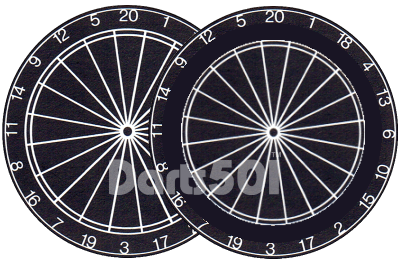
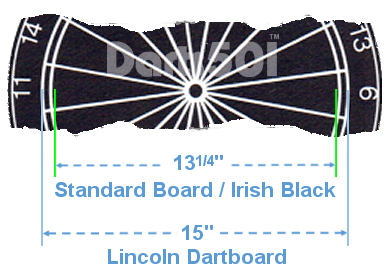
Two distinctive dartboards are the Lincoln and the Black Irish Dartboards. Both entirely Black in colour and are designed along the same lines as the Yorkshire dartboard featuring only a double ring and centre Bullseye. These two dartboards, however, are different, and from a casual glance, you would be forgiven for not recognising the difference.
A standard dartboard playing surface dia 13 ¼“ as per the Yorkshire dartboard and indeed the Black Irish however the Lincoln or Lincolnshire Dartboard is slightly bigger. Fortunately have personally seen both boards when they were sold in the Manchester-based dartboard and darts supplier, Perrigo. Although read old books and it is clear some writes certainly haven’t seen the boards as they have referred the Lincoln and Irish Black like the one of the same.
The Lincoln dartboards playing surface diameter is 15”, and the double size is 1/8" (3.2mm). I haven’t as yet established why the Lincolnshire was made this way, and some reproductions of this board contribute to the confusion by incorrectly naming a Black Irish with the name 'Lincoln' when it truly isn't. I refer this to a ‘Hockey’ / ‘Oche’ moment, i.e. missed in translation when new word sticks because it was misheard or misinterpreted.
The setup for the two dartboards is again different. The Lincoln 5’8” Centre Bull to the ground, Oche length 7’ ground level, bull to floor 9’
Both dartboards regardless of size, have the same playing rules. There is no difference in the standard #01 games. More regional dartboard setup details can be found here.
My thanks to John Lowe, Yorkshire Darts and Lincoln District Darts Leagues for the information they have provided. The Guinness book of darts Dereck Brown, Pubs Games by Arthur R. Taylor and Darts Keith Turner
A further note regarding the Lincoln and Irish Black Dartboards
It is worth noting handmade Lincoln, Irish Black and the Manchester log-end dartboards were made from a Manchester Dartboard supplier Perrigo and the differences were plain to see. Perrigo has since stopped production of the wooden dartboards. However, some of the boards are still made and can be purchased elsewhere.
It is also worth noting that a well-known dartboard manufacturer also makes a black dartboard naming it as a Lincoln. However, on enquiry, the board is of standard size and incorrectly given the ‘Lincoln’ name. The board should have been named an Irish Black. (ref Guinness book of darts by Derek Brown and first-hand experience via Perrigo, Droylsden, Manchester)
Lincolnshire, like all counties in the UK like hold onto their tradition and identity. The traditional Lincoln dartboard may not now be readily available. It is not true that the Lincoln board has reduced in size as some might have you believe. Writers have said the board was reduced in size because it was easy to make! Easier to make, this is true because it follows the same structure and dimensions as a Yorkshire dartboard / Irish Black.
It is believed some of the Lincoln Dartboard leagues agreed to the change of size to help the manufacturer, and so they can keep some form of identity.
Lincolnshire dartboards advertised today are likely to be the same size and construction as the Yorkshire and Irish Black Dartboards, however, whether you can still call this revised size dartboard a Lincoln dartboard is debatable.
![]()
Kent (Doubles)
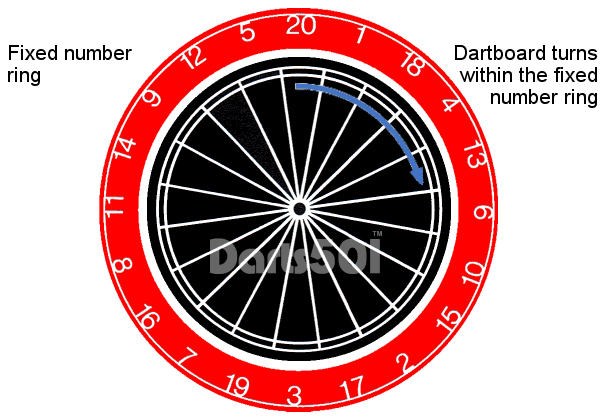
Although the Yorkshire dartboard can still be easily be found, the Kent doubles is a little rarer. However, I believe leagues still exist. The origins of the Kent Doubles stem from the Yorkshire Dartboard. Basically, both dartboards are the same size although some references say the original Kent dartboard size was bigger than the Yorkshire dartboard. If, however, the Yorkshire miners first brought the dartboard to the Kent Region, I would suggest it is / was the same size. Both dartboards only feature single, doubles and a centre bullseye, not an outer bull as you see on a London Clock or as some call it the standard dartboard.
Traditionally the Yorkshire, Irish Black and Kent also referred to as the Kent Doubles dartboard were made from elm/poplar wood. The County of Kent gained its’s own doubles board when the miners from Yorkshire took their dartboard to the Kent coalfields. Players of the Manchester log-end dartboard would know the numbering system was hammered into the board, not much of an issue for a Manchester dartboard because the game is unique and not concentrated on one main high-level scoring section. This is not true of the Yorkshire or Kent board so the boards were manufactured without any numbers. The dartboard was then nestled inside a number ring. This allowed the board to be turned so it had even wear. Yorkshire dartboard and London clock dartboards today have a removable number ring allowing you to reposition the numbers after you have turned it. The illustration shows the traditional Kent board without numbers nestled in a fixed number ring. I believe some still survive while some Kent leagues now use a Yorkshire dartboard.
The rules for Kent (Doubles) Dartboard are the same as the Yorkshire Dartboard.
![]()
The Grimsby Dartboard
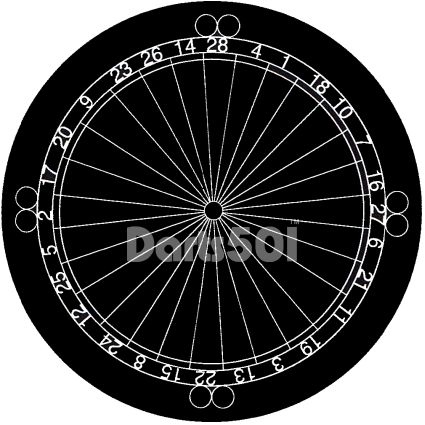
The Grimsby Dartboard is unique in a few ways. Firstly, it has 28 scoring segments a bull and a doubles ring. In addition and external to the main scoring area are four sets of dual rings situated at the north, east, south, west pole position.
The rules for this board I have been unable to find, however, it is likely the dual ring may have been used to start and finish a game. i.e. hit one of the target areas to start and or finish. The rings, of course, could have been used for other dart games and these could have been used as a forerunner of the game loop / loopy (see standard dartboard games).
The board was made c 1880 and there is photo evidence showing the board in 1890. The board would have been made from elm and soaked to make the board into a playable condition.
![]()
Bath Dartboard
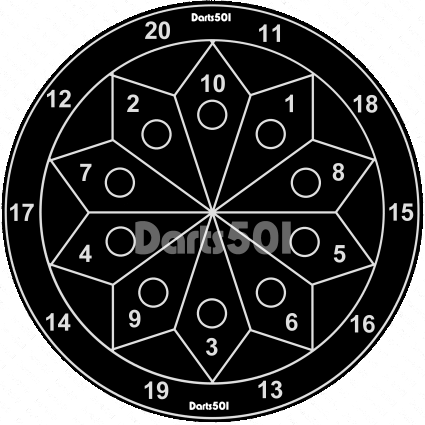
Like other dartboards that feature, UK Regional Dartboards are given the name of where they were first played/originated. Every so often, history digs up another dartboard for us to ponder over. Dart's history Dr Patrick Chaplin doesn't know the answer on this occasion because little written evidence has become available.
The Bath Dartboard was a feature circa the 1900s. Like other dartboards made at the time, the dartboard was made from a log end, presumable, 'Elm' or another softwood such as 'Poplar'. Like the Manchester Dartboard and other UK Regional dartboard variations, the dartboard would have had to be kept damp and submerged in water to heal the dart holes that would have been generated. Soaking the wood dartboard would also stop the board from splitting.
Rules for this dartboard have yet to be found. However, darts in the 1900s would have been made from weighted wood with feather flights and not designed to be grouped like the modern-day darts. The games likely followed simple rules such as around the clock, hitting each numbered segment in sequence. It is also possible the circle areas in segments 1-20 may have been a higher scoring area, such as treble the segment area value. Similarly, the outer scoring numbers may have been used as the finishing segments, but this is conjecture.
What can be seen is the numbers 1-20 is used. This is the same numbering we tend to use today without the centre or outer bullseye.
The Bath Dartboard also has some similarities to the Tunbridge, Seven Oaks League Dartboard, i.e., triangular scoring segments towards the edge of the board, but any similarity ends.
Dr Patrick Chaplin does feature the Bath Dartboard on his website, and it is evident from a photo he features, a league or team of some sort was in place in 1906.
If you have any further information regarding this dartboard, please drop me an email.
I have recreated the dartboard so you can see how it once looked. The overall dartboard size would have been of a similar size to today's standard dartboard, based upon a photo image of 1906.
(Please do not copy or use graphics created for this website.)
![]()
Darts Research – Stafford / Burton Dartboard
When it comes to dart research, I have found that not all you read is true. It is not the case the writer has deliberately gone out of their way to deceive more to the fact that they gain their information from what they may believe to be a trusted source, i.e. They may have first-hand experience or indeed local rules they may have played.
I am a collector of old books, and it is clear to see how darts has changed over the past 100 years. Dartboard height, throwing distances, local variations such as not bust rule and indeed regional dartboards of which there have been many.
The example of the Stafford Dartboard (no longer made) has been taken from various sources of information including the ‘Guinness Book of Darts’ by Derek Brown. Brown describes the board and rules in some detail an illustrates the book with a pen and ink design. I have reproduced the board below based on the information provided, however, a recent purchase of yet another old book, ‘Darts - The Complete Book of the Game’ by Keith Turner decides the board and the rules differently. As yet, I have not been able to establish which one is correct or indeed, if both are correct! A further illustration can also be found in Pub Games Arthur R. Taylor, who also depicts the board with an inner and outer bullseye but provides no rules. In fact, in another book by Arthur R. Taylor, ‘Played in the Pub’ he illustrates the Staffordshire dartboard with only a single bull. Maybe there were two?
Areas of Stafford known for its strong relationship with darts could have had two variations of the board. It is believed, the board went out of existence before the 1970s. However, this could relate to an earlier researcher just trying to find information around this time as no further reference was given.
If a reader has an original PHOTO of an old version of this board, it would certainly give more credence to one of these two designs I have shown below. As regard research evidence is critical. Writers of books and on the internet can reproduce information as they have read believing this to be true without providing source information. Hence, I try like many others to provide information that is accurate and correct.
As regards the two boards it seems more pursuable the board was the variation of the Yorkshire dartboard and only had one single bullseye; however, this may not be true.
(keeping history alive)
Staffordshire / Burton Dartboard
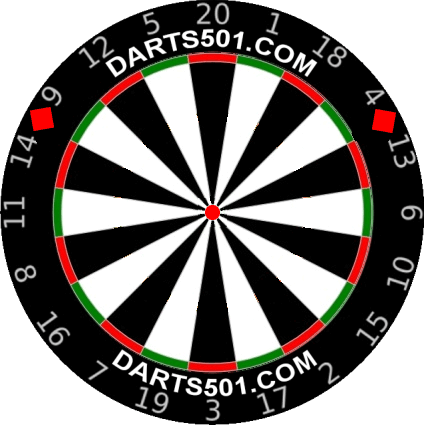
The Stafford / Burton Dartboard as described in the Guinness book of darts by Derek Brown and serval other publications, probably taking their research from such a publication. The Stafford / Burton Dartboard is described as a variation of the Yorkshire dartboard with two additional squares situated between the 14 and 9, the other between 4 and 13. The squares slightly turned scored each scored 25. The board has described also had no treble ring or out-bullseye. The addition of the 25-scoring square could be used to score on but could not be used for an outshot!
This dartboard is sadly no longer made.
Staffordshire / Burton Dartboard (Variation?)

In total contrast to the design and rules stated in the Guinness book of Darts, ‘Darts- The complete Book of the Game by Keith Turner describes the board differently.
Turner describes the dartboard like a Yorkshire doubles board with two difference. The board has an out-bullseye and the addition of two scoring squares in the same location as Brown states between 14 and 9, the other between 4 and 13. However, Turner states the square could be used for an out-shot.
Brown does give some additional resource information as regards makers in the Guinness book. However, could there have been a variation?
A further illustration of this arrangement can also be found in Pub Games Arthur R. Taylor
This dartboard is sadly no longer made.
![]()
Tunbridge Dartboard or Sevenoaks League Board
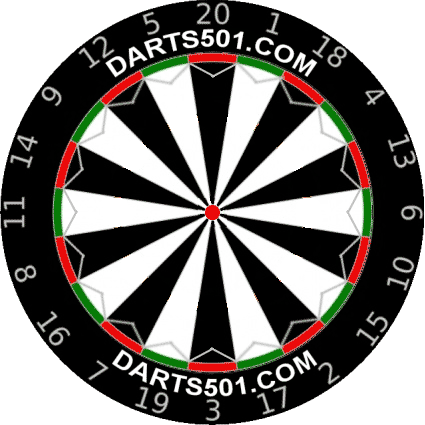
Used in the Tunbridge-Sevenoaks area of Kent, this board also has another name the Trebles board due to its special arrangement. What would typically be a doubles ring on a London Dartboard is a trebles ring on a Tunbridge. The numbering sequence and dimensions are the same as a standard London dartboard. However, this board doesn’t feature an outer-bullseye. The double on this board consists of the triangular segments inside the treble ring which mean you can bust either side of the double!
This dartboard is sadly no longer made.
![]()
Norfolk Dartboard

This small target boat was used in parts of Norfolk up until the 1940s according to Arthur Taylor in his book ‘Pub Games’. The board was made from elm and required regular soaking to prevent the board from cracking and to heal the hole darts made in the board. The dartboard was rather small, just 10” in diameter. The centre Bullseye 1”, the out-bullseye 2” while a third scoring ring was 6”. The outer black area shown in my illustration was a no scoring area.
Score values were inner-bullseye 2, outer bullseye 3, the third ring 1. The game was simply first to score 31 which would have been scored on a cribbage board like early 301 games on other boards.
The diagram is for illustration purposes only. The segment colour shows the separate scoring areas, but may not be true to the board.
This dartboard is sadly no longer made.
![]()
Club or Tournament Dartboard
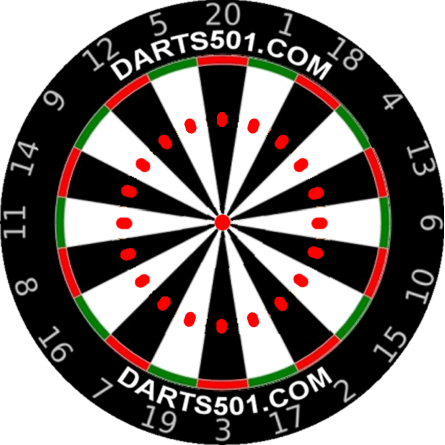
Until recently, I have never come across this strange hybrid dartboard. The Club Board is also known as the Tournament Board! Features oval shaped treble scoring segments and no outer-bullseye, otherwise similar to the London Clock dartboard. This dartboard apparently had no area stronghold but featured in workingmen’s clubs (hence its name) rather than any specific town or region. According to Keith Turner in his book ‘Darts the complete book of the Game’, the locals' rules attributed either 50 or 100 to the Bullseye.
I have no further reference to this board or indeed who made it. It seems a 180 might have been a little though.
The name Club or Tournament board is sometimes attributed to a club’s second or match dartboard. I.e. one board for practice the other for matches between rival, clubs, pubs or teams.
No longer made
Diagram for illustration purposes only.
![]()
Keepdrye Paper Coil Dartboard circa 1940s
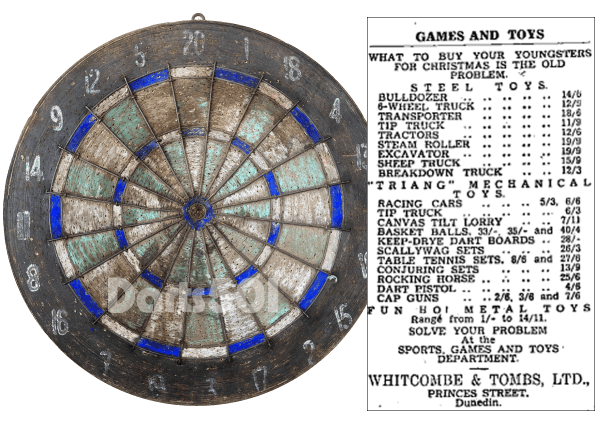
Keepdrye Dart Board | Pat 350250 | Darts Must be Kept Sharp
Keepdrye were a dartboard manufacturer based in Basildon, Essex. They were situated next to a cracker factory (Wagners's Christmas cracker factory, on the A127, Laindon). Both Keepdrye and the cracker factor have since closed. The dartboard example shown here is not of a standard size, measuring 27cm in dia (outer double ring). It is 3.5cm in depth and has a dowel (wood) centre bullseye with coiled paper making up the rest of the dartboard. The dartboard is secured with a metal band, and this is embossed, as far as I can make out, with the words KEEPDRYE DART BOARD PAT 350250 DARTS MUST BE KEPT SHARP.
Keepdrye also made full-size dartboards, but this one may have been designed for the children's market. They sold their dartboards all over the world, as this advert indicates from the New Zealand Otago Daily Times Newspaper, December 13, 1947
![]()
Fun Dartboards

There have been many fun dartboards produced over the years. Notably the Card Dartboard being one of the most popular. The combination of darts, cards and betting have always been closely linked. However it isn’t unusual to see many popular sports being made into dartboard games: Golf, Baseball and Snooker are just a few. All of these boards are produced for fun dart games and rarely will you see a serious dart player playing on one.
![]()
Paper Kids Dartboard and Target
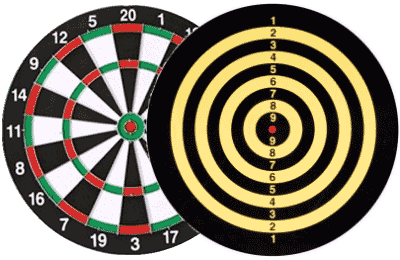
The kid’s entry dartboard is made from coiled paper. The centre Bullseye being made from a wooden dowel. The dartboard is made two sided unlike the Bristle boards we generally use.
The main board is a standard clock dartboard and the reverse a straight target board. Decreasing circles form a 1 -10 target area rather like an archery target. The smallest circle, the bullseye, is awarded 10 points the far most ring 1. A basic game on who can score the most in a given amount of throws and basically where it all began the Target board.
Paperboards don’t last and in a short period of time they will be heading for the bin however they do have their place as the starter dartboard for the next budding World Champion.
![]()
Dartboards of the Past and Present
Hundreds of different dartboards have been made over the years, however, only some survive today. Most boards now are a variation on the London clock dartboard well others have connections to other games such as baseball, golf, snooker, cards and even word games! It is now possible to obtain a dartboard with your own illustration on it so the opportunity to bring some of the old style dartboards back is always there.
Dartboard Advertising
Dartboard advertising has been around for years. Locally breweries, Internally Tobacco firms, and a host of others would commission dartboards to be given away to pub and clubs to advertise their name. This was great for the pubs as they didn’t need to buy a board and a cheap form of advertising for companies.
Dart flights, and in some cases, darts were also supplied. The boards tended to reflect the company’s corporate colours to distinguish the scoring segments, however, others used the standard colourway of black, red, green and natural so they would confirm to darts league specification. Below are a few examples:

Football Dartboards
Dartboards have also been designed to reflect other sports, namely football. In the UK top-flight teams from both the English and the Scottish Premiership Football have their own dartboard! For fans of clubs this might be an ideal present to buy for birthdays or Christmas.
In the USA, dartboards have been and still are made to customers specification. American Football or even a photo reproduced on a board can be popular. However, personally, the top-quality dartboards with thin blade wiring will also be my personal preference. Here are some football dartboards examples:

Funfair and Other Dartboards
Funfair dartboards have had their own styles. Many just designed to set a target for the punter. These varied in size, style and target area.
Below are just a small handful of the many that have been made over the years.
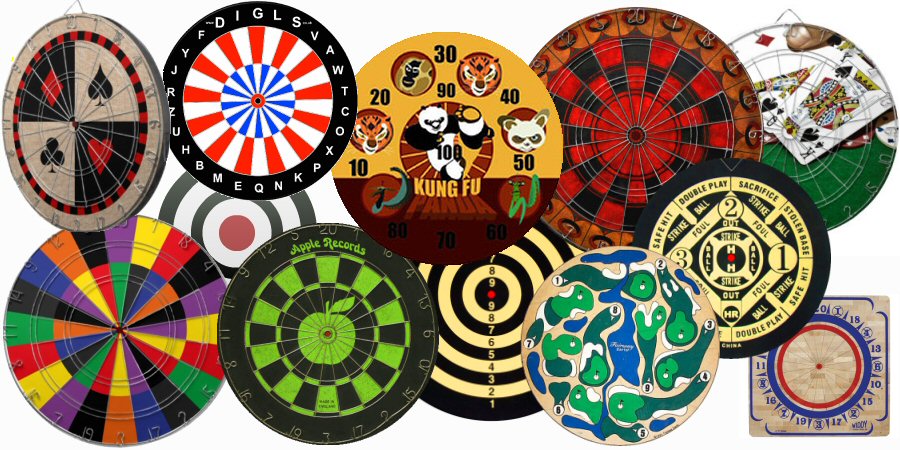
Acknowledgements | Privacy, Cookies & Terms of Use | FAQ


